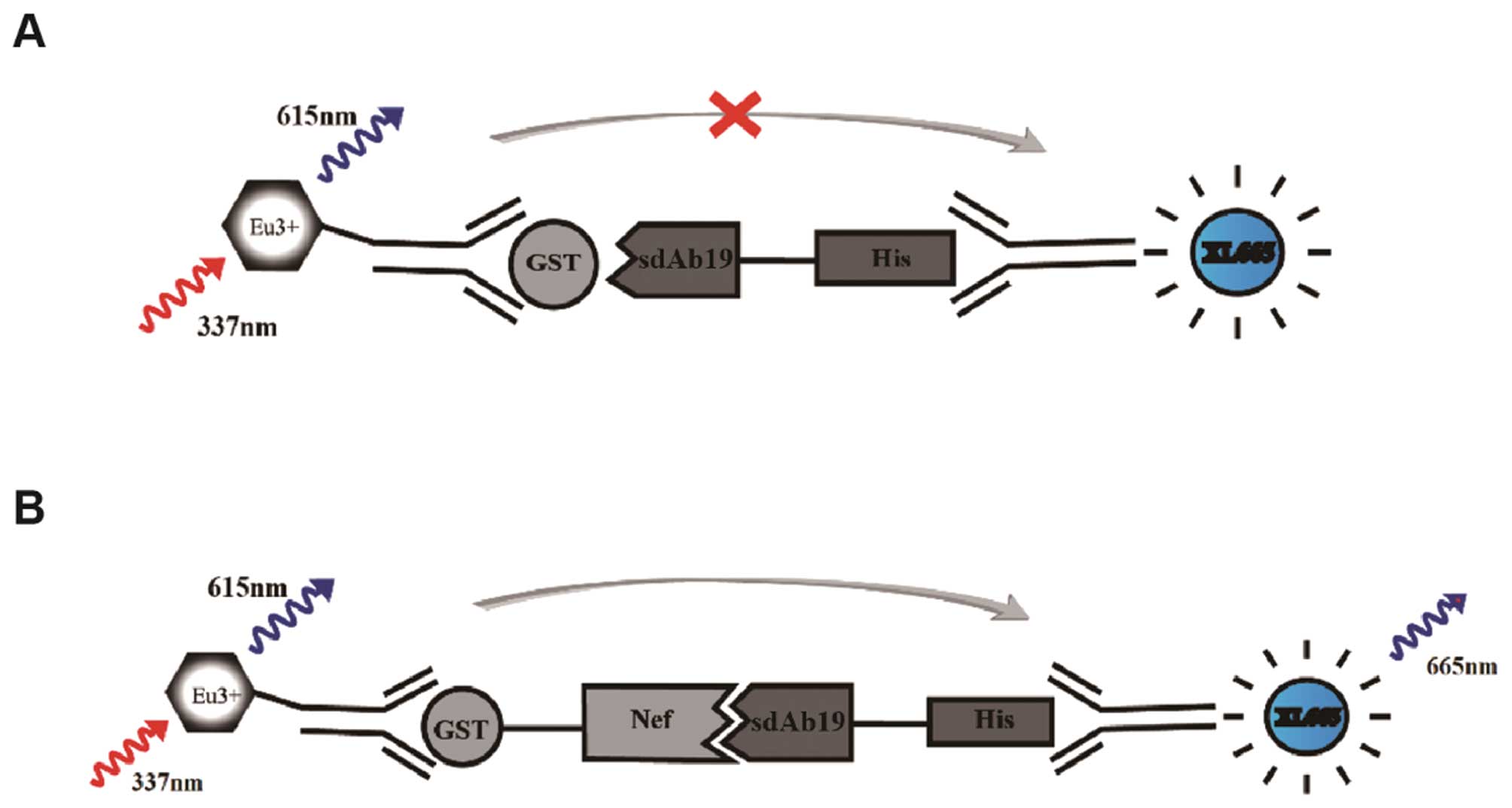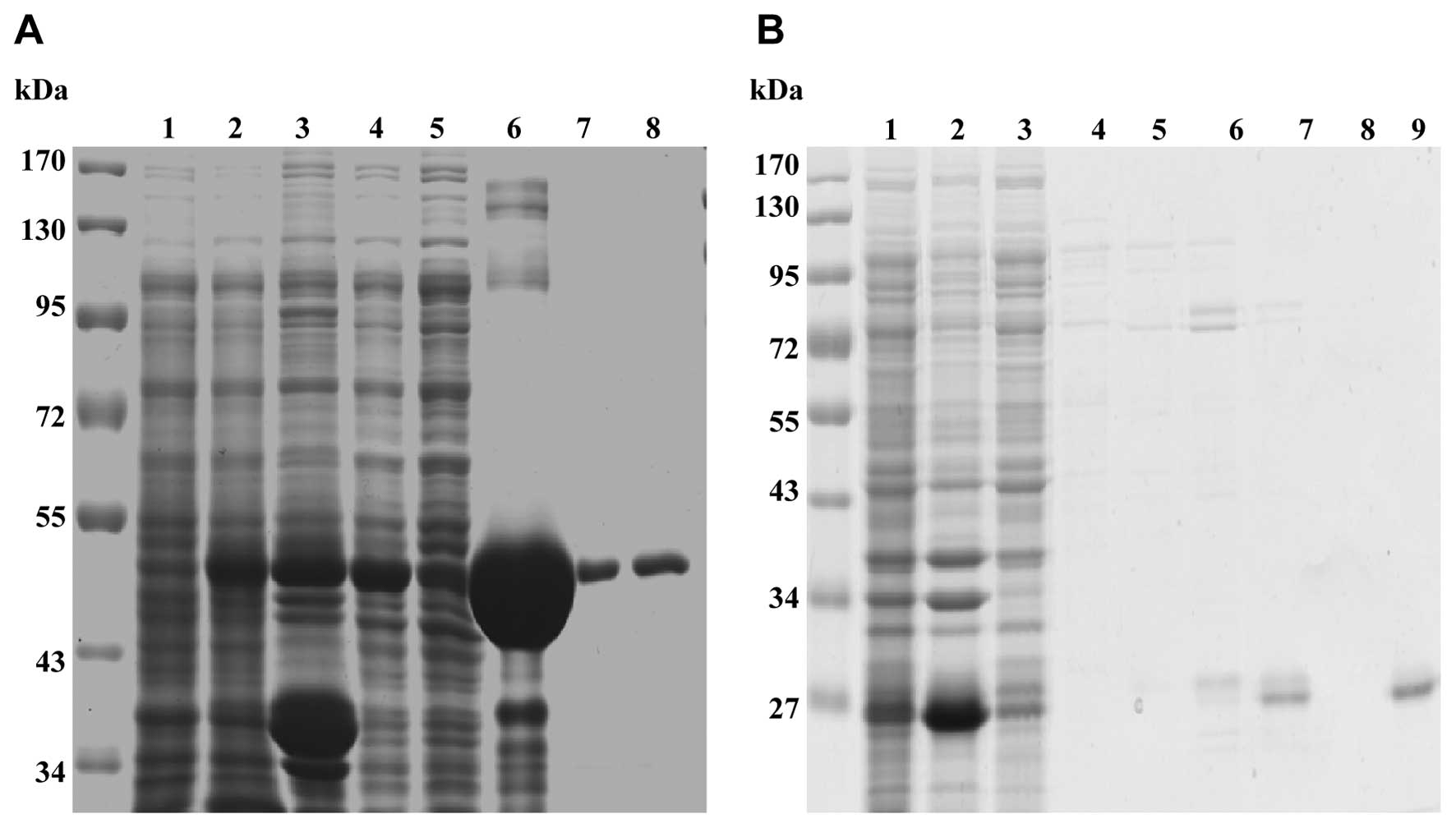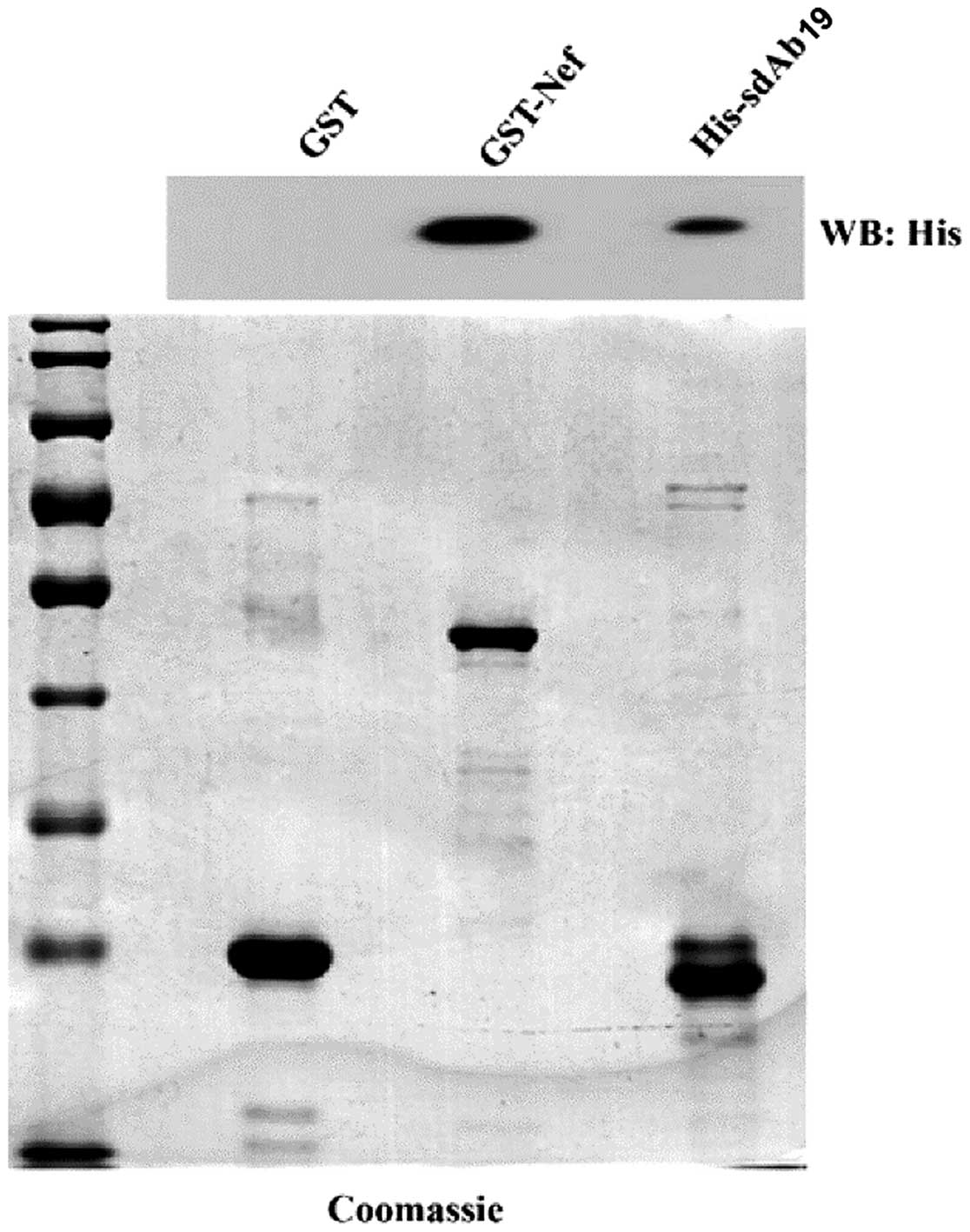|
1
|
Greene WC: The brightening future of HIV
therapeutics. Nat Immunol. 5:867–871. 2004. View Article : Google Scholar : PubMed/NCBI
|
|
2
|
Foster JL and Garcia JV: HIV-1 Nef: At the
crossroads. Retrovirology. 5:842008. View Article : Google Scholar : PubMed/NCBI
|
|
3
|
Kestler HW III, Ringler DJ, Mori K,
Panicali DL, Sehgal PK, Daniel MD and Desrosiers RC: Importance of
the nef gene for maintenance of high virus loads and for
development of AIDS. Cell. 65:651–662. 1991. View Article : Google Scholar : PubMed/NCBI
|
|
4
|
Fackler OT and Baur AS: Live and let die:
Nef functions beyond HIV replication. Immunity. 16:493–497. 2002.
View Article : Google Scholar : PubMed/NCBI
|
|
5
|
Shugars DC, Smith MS, Glueck DH, Nantermet
PV, Seillier-Moiseiwitsch F and Swanstrom R: Analysis of human
immunodeficiency virus type 1 nef gene sequences present in vivo. J
Virol. 67:4639–4650. 1993.PubMed/NCBI
|
|
6
|
Kwak YT, Raney A, Kuo LS, Denial SJ,
Temple BR, Garcia JV and Foster JL: Self-association of the
Lentivirus protein, Nef. Retrovirology. 7:772010. View Article : Google Scholar : PubMed/NCBI
|
|
7
|
Cruz NV, Amorim R, Oliveira FE, Speranza
FA and Costa LJ: Mutations in the nef and vif genes associated with
progression to AIDS in elite controller and slow-progressor
patients. J Med Virol. 85:563–574. 2013. View Article : Google Scholar : PubMed/NCBI
|
|
8
|
Foster JL, Denial SJ, Temple BR and Garcia
JV: Mechanisms of HIV-1 Nef function and intracellular signaling. J
Neuroimmune Pharmacol. 6:230–246. 2011. View Article : Google Scholar : PubMed/NCBI
|
|
9
|
Bouchet J, Basmaciogullari SE, Chrobak P,
Stolp B, Bouchard N, Fackler OT, Chames P, Jolicoeur P, Benichou S
and Baty D: Inhibition of the Nef regulatory protein of HIV-1 by a
single-domain antibody. Blood. 117:3559–3568. 2011. View Article : Google Scholar : PubMed/NCBI
|
|
10
|
Muyldermans S: Single domain camel
antibodies: Current status. J Biotechnol. 74:277–302.
2001.PubMed/NCBI
|
|
11
|
Roovers RC, Laeremans T, Huang L, De Taeye
S, Verkleij AJ, Revets H, de Haard HJ and van Bergen en Henegouwen
PM: Efficient inhibition of EGFR signaling and of tumour growth by
antagonistic anti-EFGR Nanobodies. Cancer Immunol Immunother.
56:303–317. 2007. View Article : Google Scholar
|
|
12
|
Gueorguieva D, Li S, Walsh N, Mukerji A,
Tanha J and Pandey S: Identification of single-domain, Bax-specific
intrabodies that confer resistance to mammalian cells against
oxidative-stress-induced apoptosis. FASEB J. 20:2636–2638. 2006.
View Article : Google Scholar : PubMed/NCBI
|
|
13
|
Hultberg A, Temperton NJ, Rosseels V,
Koenders M, Gonzalez-Pajuelo M, Schepens B, Ibañez LI,
Vanlandschoot P, Schillemans J, Saunders M, et al: Llama-derived
single domain antibodies to build multivalent, superpotent and
broadened neutralizing anti-viral molecules. PLoS One.
6:e176652011. View Article : Google Scholar : PubMed/NCBI
|
|
14
|
Ohmi N, Wingfield JM, Yazawa H and Inagaki
O: Development of a homogeneous time-resolved fluorescence assay
for high throughput screening to identify Lck inhibitors:
Comparison with scintillation proximity assay and
streptavidin-coated plate assay. J Biomol Screen. 5:463–470. 2000.
View Article : Google Scholar
|
|
15
|
Degorce F: HTRF®: Pioneering
technology for high-throughput screening. Expert Opin Drug Discov.
1:753–764. 2006. View Article : Google Scholar : PubMed/NCBI
|
|
16
|
Jia Y, Quinn CM, Gagnon AI and Talanian R:
Homogeneous time-resolved fluorescence and its applications for
kinase assays in drug discovery. Anal Biochem. 356:273–281. 2006.
View Article : Google Scholar : PubMed/NCBI
|
|
17
|
Chen X, Longgood JC, Michnoff C, Wei S,
Frantz DE and Bezprozvanny L: High-throughput screen for small
molecule inhibitors of Mint1-PDZ domains. Assay Drug Dev Technol.
5:769–783. 2007. View Article : Google Scholar : PubMed/NCBI
|
|
18
|
Mohamed TM, Zakeri SA, Baudoin F, Wolf M,
Oceandy D, Cartwright EJ, Gul S and Neyses L: Optimisation and
validation of a high throughput screening compatible assay to
identify inhibitors of the plasma membrane calcium ATPase pump - a
novel therapeutic target for contraception and malaria. J Pharm
Pharm Sci. 16:217–230. 2013.
|
|
19
|
Lemay J, Maidou-Peindara P, Bader T,
Ennifar E, Rain JC, Benarous R and Liu LX: HuR interacts with human
immunodeficiency virus type 1 reverse transcriptase, and modulates
reverse transcription in infected cells. Retrovirology. 5:472008.
View Article : Google Scholar : PubMed/NCBI
|
|
20
|
Seidel SA, Dijkman PM, Lea WA, van den
Bogaart G, Jerabek-Willemsen M, Lazic A, Joseph JS, Srinivasan P,
Baaske P, Simeonov A, et al: Microscale thermophoresis quantifies
biomolecular interactions under previously challenging conditions.
Methods. 59:301–315. 2013. View Article : Google Scholar :
|
|
21
|
Fischer WB, Wang YT, Schindler C and Chen
CP: Mechanism of function of viral channel proteins and
implications for drug development. Int Rev Cell Mol Biol.
294:259–321. 2012. View Article : Google Scholar : PubMed/NCBI
|
|
22
|
Izzedine H, Launay-Vacher V, Deray G and
Hulot JS: Nelfinavir and felodipine: A cytochrome P450 3A4-mediated
drug interaction. Clin Pharmacol Ther. 75:362–363. 2004. View Article : Google Scholar : PubMed/NCBI
|
|
23
|
Idriss HT: Questions regarding the role of
protein phosphorylation in HIV replication and anti-acquired immune
deficiency syndrome therapy. Saudi Med J. 26:7–10. 2005.PubMed/NCBI
|
|
24
|
Jakubiec A and Jupin I: Regulation of
positive-strand RNA virus replication: The emerging role of
phosphorylation. Virus Res. 129:73–79. 2007. View Article : Google Scholar : PubMed/NCBI
|
|
25
|
Behrend L, Milne DM, Stöter M, Deppert W,
Campbell LE, Meek DW and Knippschild U: IC261, a specific inhibitor
of the protein kinases casein kinase 1-delta and -epsilon, triggers
the mitotic checkpoint and induces p53-dependent postmitotic
effects. Oncogene. 19:5303–5313. 2000. View Article : Google Scholar : PubMed/NCBI
|
|
26
|
Yang WS and Stockwell BR: Inhibition of
casein kinase 1-epsilon induces cancer-cell-selective,
PERIOD2-dependent growth arrest. Genome Biol. 9:R922008. View Article : Google Scholar : PubMed/NCBI
|
|
27
|
Zhou YX, Karle S, Taguchi H, Planque S,
Nishiyama Y and Paul S: Prospects for immunotherapeutic proteolytic
antibodies. J Immunol Methods. 269:257–268. 2002. View Article : Google Scholar : PubMed/NCBI
|
|
28
|
Evans TR and Kaye SB: Retinoids: Present
role and future potential. Br J Cancer. 80:1–8. 1999. View Article : Google Scholar : PubMed/NCBI
|
|
29
|
Kaleagasioglu F, Doepner G, Biesalski HK
and Berger MR: Antiproliferative activity of retinoic acid and some
novel retinoid derivatives in breast and colorectal cancer cell
lines of human origin. Arzneimittelforschung. 43:487–490.
1993.PubMed/NCBI
|
|
30
|
Hua S, Kittler R and White KP: Genomic
antagonism between retinoic acid and estrogen signaling in breast
cancer. Cell. 137:1259–1271. 2009. View Article : Google Scholar : PubMed/NCBI
|
|
31
|
He JC, Lu TC, Fleet M, Sunamoto M, Husain
M, Fang W, Neves S, Chen Y, Shankland S, Iyengar R, et al: Retinoic
acid inhibits HIV-1-induced podocyte proliferation through the cAMP
pathway. J Am Soc Nephrol. 18:93–102. 2007. View Article : Google Scholar
|
|
32
|
Lu TC, Wang Z, Feng X, Chuang P, Fang W,
Chen Y, Neves S, Maayan A, Xiong H, Liu Y, et al: Retinoic acid
utilizes CREB and USF1 in a transcriptional feed-forward loop in
order to stimulate MKP1 expression in human immunodeficiency
virus-infected podocytes. Mol Cell Biol. 28:5785–5794. 2008.
View Article : Google Scholar : PubMed/NCBI
|
















